KENYA BIRDS AS ART/GUSTAPHOTO KENYA SAFARI REPORT
BAD PUN?
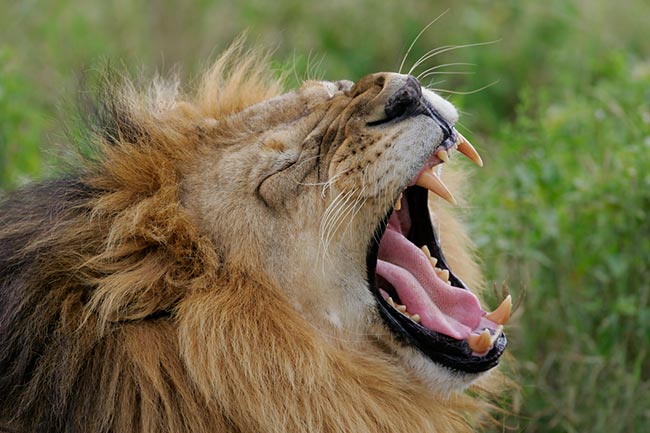
This lion was sleeping right next to a tree. I was as bored as he was. The next thing you know, he lets out with this big yawn so I make two images not expecting much. Surprise. Love those teeth my dear!
ON THE ROAD YET AGAIN!
I am flying to Anchorage this Thursday to photograph coastal brown bears fishing for salmon and to do a bit of fishing myself. I will do my best not to get eaten by a bear. I will effectively be out of touch until late September. Jim and Jennifer will be here to help you with mail orders, IPT registrations, etc. If you have some fresh, new questions for me, please hold onto them until after September 25th. Thanks. I hope to meet many of you at the Dallas Seminar.
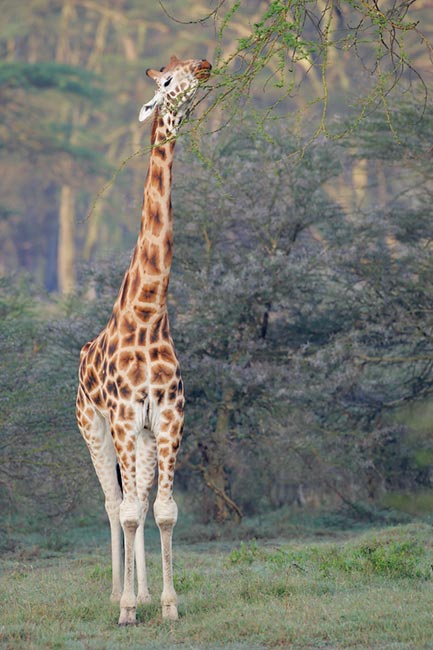
The giraffes at Nakuru were exceptionally cooperative this year. On previous visits, they always stayed far from the tracks; this year, they often paraded right by the vans. Notice that in this image and the image above, I chose f/5.6 as my aperture rather than working wide open. With the giraffe stretched out to full height and a rather pleasing background, this is one of my favorite giraffe photos. I just hate giraffe images where the animal is sliced in two by the horizon line...
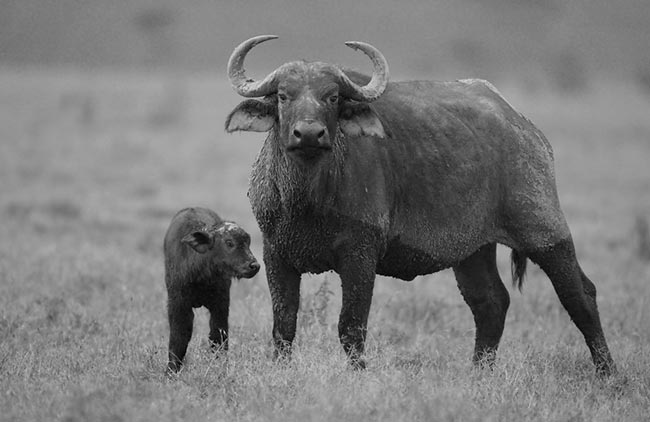
Though this image was made at ISO 3200, there is little noise evident. I converted this image to B&W at the suggestion of George Rodrigues. Thanks George!
.....
BAD PUN?
How bad is this pun? What did the woman say who did not want any ill-tempered wildebeests brought to her location? See the hint below.
.....
All in all, the trip was extremely depressing. Why? Having to look at Todd Gustafson's amazing images each day left me wondering what safari I was on. And that was true even after Todd and I had photographed from the same van. Without question, there is no one in the world better at photographing from the open roof hatch of a safari van than Todd. Several of us attempted to figure out how he does it and here is what we came up with: Todd is always ready. He is always standing with his 600mm lens mounted on a Wimberley head atop his Todd-Pod, and the rig is always on the correct sun-angle side of the van. Todd knows the animals better than they know themselves. He knows what they will do and when. He is a great spotter, far better than even the most experienced guide. He is fast and strong and amazingly creative. He is brave enough (or foolish enough) to change teleconverters on the fly, i.e. while the vehicle is traveling at the park speed limit. And on at least two occasions I have seen him make sharp images with a big lens and a 2X TC when the vehicle was moving at 20-30 km/hr. And when the van stops, he is there, ready to make another great image at the first available (and often the only possible) instant. As I said, it is all very depressing. When I return from Alaska we will publish a gallery of Todd's amazing work.
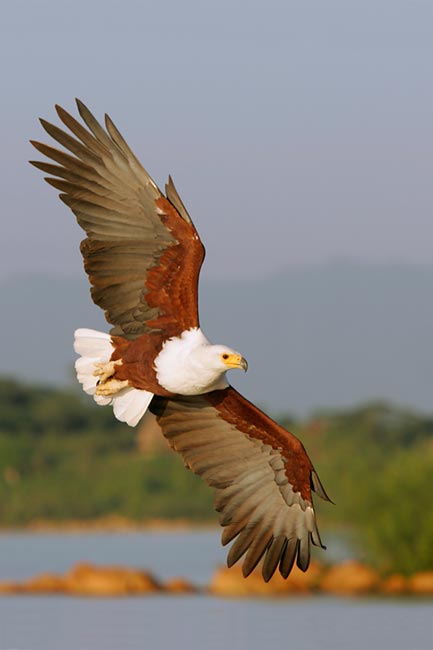
Though we had great weather at Baringo, we were plagued by wind against sun conditions every morning. The only good images were made as the birds banked before their dive. Note again my choice to go with an aperture one stop smaller than wide open (while still maintaining an adequate shutter speed. HINT
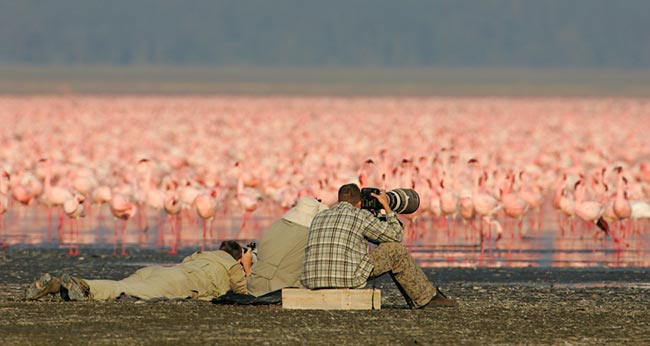
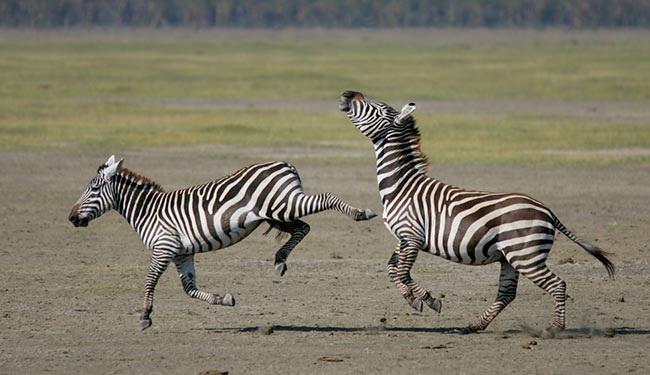
We had some great opps with zebra action at Nakuru. This image succeeds despite the less than ideal sun angle... Note the shadow to the rear of the right-hand animal.
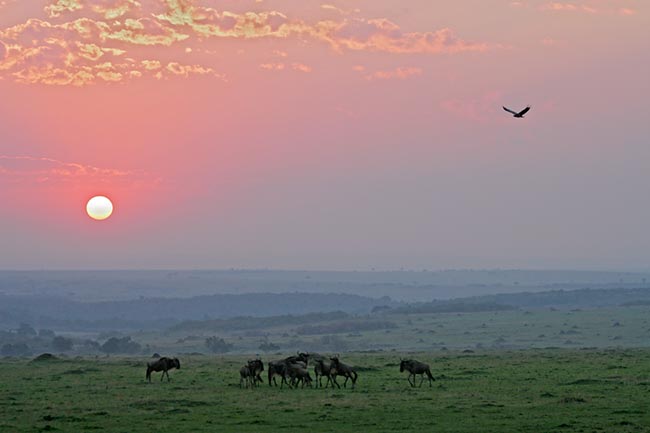
In this case, the presence of the wildebeests was good news. Skilled nature photographers keep their eyes moving even when photographing a dramatic scene or subject. Doing so allowed me to see the vulture coming, let the group know about it, and still have time to place it in the upper right for best compositional balance.
TWO NEW CANON DIGITAL CAMERAS ANNOUNCED
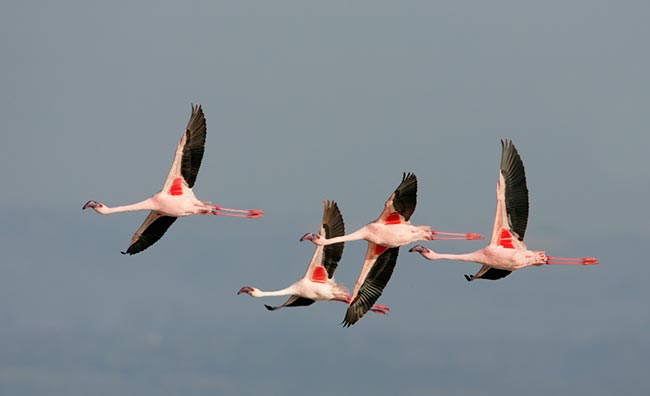
You can do everything right in terms of exposure and focus and depress the shutter button an instant before it seems as if the birds will be lined up perfectly in the viewfinder and still wind up with junk. Here, I was fortunate that the last bird's head did not merge with the bird in front of it.
IPT UPDATES
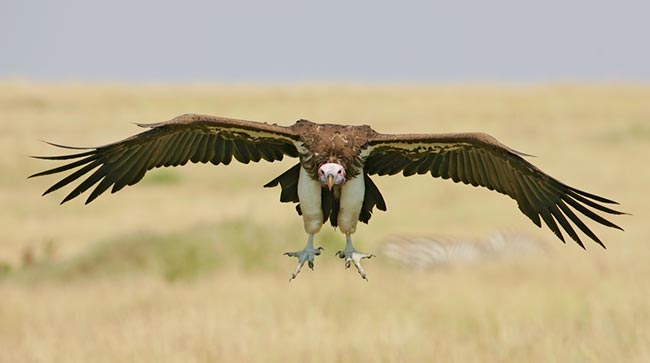
Finding a fresh kill on mornings with east winds almost always leads to spectacular flight photography with the vultures. 45-Point AFPS nailed the focus on this one. FORT DESOTO IPT, MAR 24-26, (slide program on Thursday, MAR 23 at 7pm): 3-DAY: $899 (Limit 12, 10 openings.)
Fort DeSoto has rapidly become one of my very favorite photo locations. Join us during prime time to photograph Royal and Sandwich Terns & Laughing Gulls in spectacular breeding plumage/courtship and copulations; dark and white phase Reddish Egrets in breeding plumage; many other tame heron and egret species; Forster's Terns, Long-billed Curlew and a dozen or more easily approachable shorebird species; great flight photography opportunities will be available at DeSoto. Depending on local conditions we may or may not enjoy the following in Sarasota: great flight photography opportunities; Brown Pelicans with nesting material; Great Egret, Great Blue Heron, & Black-crowned Night-Heron (head and shoulders portraits likely with this species). This IPT will include at least three slide programs.
LAKE MARTIN, LA SPOONBILL IPTs, APR 8-10, 2006 (slide program on Friday, APR 7), and APR 28-30 (slide program on Friday, APR 27). 3 -DAY: $949 (Limit 12, each with 9 openings)
Join us to photograph nesting Roseate Spoonbills, Great & Cattle Egret, and Little Blue Heron in a budding cypress swamp. We will witness and photograph a variety of courtship behaviors as well as lots of nest building. Barring a natural disaster there will be Great Egret chicks on both IPTs. Tiny spoonbill chicks are possible on the second IPT but will almost surely be difficult to photograph. Both IPTs will feature spoonbills in mind-boggling breeding plumage (unlike anything I've ever seen here in Florida), but there will be more birds in mega-breeding plumage on the first tour. The spoonbills will be courting, building nests, copulating, and fighting. Good flight photography opportunities are expected on both IPTs. 500 and 600mm lenses with 1.4 and 2X TCs are recommended; equipment rentals are available. Barred Owls are guaranteed. There will also be Green Heron, both night-herons, scenic sunrises, nutria, alligators, and lots of flowers. Sunny afternoons will be tough at Lake Martin but mornings will be spectacular. With cloudy weather the days will be long... This IPT includes four slide programs. Registration includes a complimentary homemade crawfish etouffe dinner: hosts: Wes and Patti Ardoin. (Fly to Lafayette, La.)
ST. AUGUSTINE ALLIGATOR FARM IPTHeron and egret rookery. Nesting Great Egrets with chicks, nesting Snowy and Cattle Egrets, and Tricolored Herons. Courtship behaviors, copulations, eggs, nests and possibly tiny chicks. Includes three classroom sessions in air-conditioned comfort during the heat of the day. The introductory slide program will be at 2pm on Friday May 12, 2006.
January 2006 Tanzania Photo-Safari with co-leader Todd Gustafson. January 16-30, 2006 (14 full and one half-day of photography): $7762.50/person. Non-refundable $1000 deposit required. See or request Bulletin 166 in the archives for complete details. (Sold out.)
Summer 2006 Kenya Photo-Safari with co-leader Todd Gustafson. Details to be announced. Non-refundable $1000 deposit required.
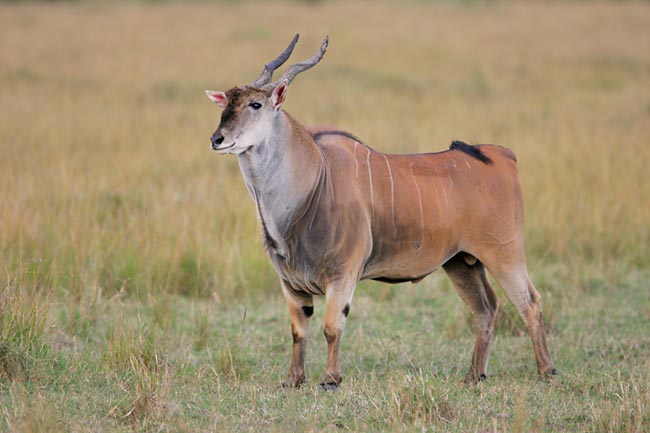
We were photographing four young Elands on our last afternoon with Mara when this huge bull sauntered out of the forest and joined them. When photographing animals wagging their tails, be aware of the postion of the tail as you make the images. Holding the shutter down is not a bad option... .....
Homer, AK Bald Eagle IPT MAR 3-7, 2006 5-day: $1699 (limit 10, 4 openings). The opportunities in Homer are beyond-spectacular. We are currently accepting $500 deposits for the 2006 Homer IPT, but these tours will be cancelled if the town, state, or Fish and Wildlife institute a ban on eagle feeding. Please do not purchase your non-refundable plane tickets until after you hear from us in November. According to some reliable information that I received just yesterday, it seems almost certain that there will not be a ban on eagle feeding at Homer in the 2005-2006 season, so the tour should be a go, but please do wait until November before making your travel plans.
Nome, Alaska IPT June 10-20, 2006 in conjunction with Greg Downing: (Greg has a single opening due to a cancellation.) Please e-mail us if you are interested in filling Greg's last slot. Long lenses are a necessity.
Antarctica/South Georgia/Falkland Islands Zegrahms Cruise with Arthur Morris and Greg Downing: January 4-24, 2007. Please e-mail birdsasart@verizon.net for details. Note: We have already filled well more than half of our allotted 30 slots for this trip...
For general IPT info, deposit and registration details, and cancellation policies, please visit: http://www.birdsasart.com/tours.html
If you would like your name placed on the waiting list for one or more trips, please e-mail, indicate the trip or trips that you are interested in, and be sure to include day, evening, and cell phone numbers. We often have late cancellations.
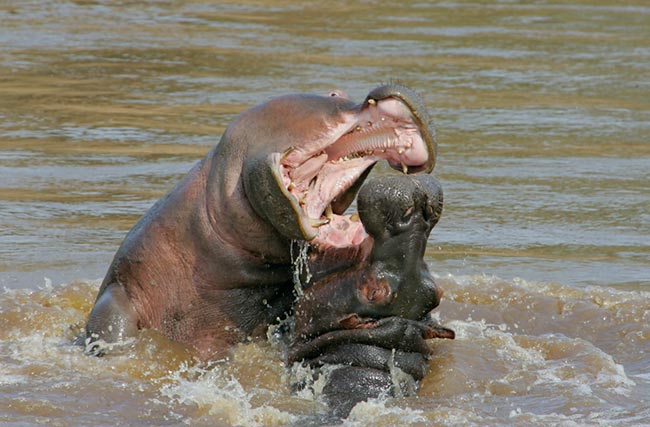
This one should, made during a long "box breakfast" stop along the Mara river, have been a vertical. Thanks once again to George Rodriquez who taught me to use the burn and dodge tools. It is amazing how much one can learn from their students. I will share what I learned in the next update of the Digital Basics File which will be e-mailed some time in mid-October.
re:
AM: Thanks for your kind words. They put a big smile on my face.
KS: After reading through the bulletin archives I have a few queries.
AM: No, I cannot. In fact, I have come to realize that with my EOS 1D Mark II cameras that exposure for digital and for film is pretty much identical. If anything, I tend to add a bit more light with the EOS 1D Mark II than I did with film. This is because reviewing the histogram allows one to expose to the right to ensure less noise and more color information. To do so with film was very risky because you were always concerned about over-exposing the highlights. WIth digital, you can add light, check the histogram or check for flashing highlights, and then proceed with no worries as long as the light does not change. With the pro-sumer bodies like the Canon EOS 10D and 20D and the Nikon N-70 series bodies, however, I recommend making your exposures 1/3 stop less than you would with film, especially with bright whites against middle, middle-dark, or dark backgrounds. But remember, with digital, you can--in all but frantic action situations--check your histogram after the first frame and then continue with complete confidence.
KS: 2. I have been using Flash as fill-in for many years, especially for bird photography I also use a Better Beamer in order to help the flash reach the subject at distances as great as 20 meters. At times, the flash could not reach the desired exposure level that I had set even though I had adjusted the ISO to 400 or 800. Can you help with this problem?
AM: You need to be using your widest aperture and make sure that the flash head is not pointed a bit downwards (as often happens with the Canon 550 flash...) I used to put a shim in under the flash head to make sure that it was properly aimed. Using the beamer will increase the flash output approximately three stops.
KS: In Bulletins 162 you mentioned that Greg Downing had taught you to use manual flash. Would it be possible for you to write an article on this subject? (The forest in Thailand is tropical rain forest; even on the sunniest days very little light penetrates to the floor of the forest. I need to use flash as main light most of the time but often I simply do not have enough flash power to illuminate the subject completely. DO you have any suggestions for using manual flash?
If you have a cooperative subject at a given distance and you are using the 580 flash, you can fine-tune the flash output in 1/3rd stop increments, say to "1:8 -1/3 stop" or to "1:4 +2/3 stops."
If your histogram is too far to the left (showing underexposure) at a given distance then you need to either get closer, use a wider aperture, or use a higher ISO. It's that simple. Best of luck. Let me know how you do. .
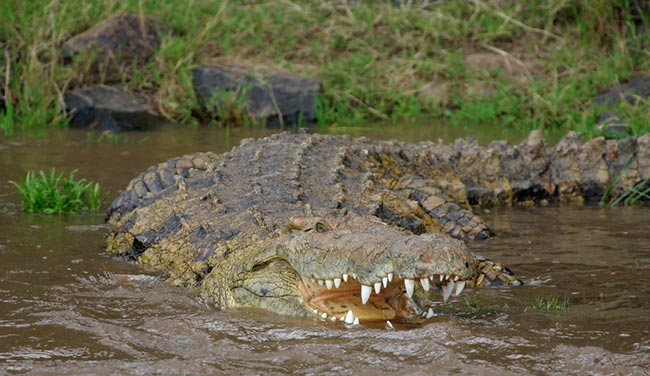
Here, I used One-Shot AF, focused on the croc's eye, and recomposed. We prayed for this large croc to open wide, but our prayers went unanswered...
This seminar is for all nature photographers who want to learn how to make better images. I will describe the methods and techniques that I have developed and used since 1983. My comments on equipment (including and especially digital equipment), autofocus, light, composition and image design, and sharpness and my tips on getting close to wild subjects and photographing action and behavior will benefit everyone with a telephoto lens who wishes to dramatically improve the quality of their images. Since going all-digital in November 2002, I have--in short order--become a digital photography and Photoshop expert. My approach to optimizing images is to create a master file of excellent quality in the shortest possible time. I will share our workflow and numerous Digital and Photoshop tips during the Sunday sessions.
Weekend package (2 days): $159. Either Saturday or Sunday: $109. To register send a check for the full amount made out to "Arthur Morris" to PO Box 7245, Indian Lake Estates, FL 33855. We accept credit cards by phone: 863-692-0906. In either case, we need your e-mail address, your mailing address, and your daytime and evening phone numbers. Here is the Cancellation Policy for these events: Photo Road Show is relying on your attendance, so if for any reason you need to withdraw, please notify Arthur Morris as soon as possible. Once we receive written notice of your cancellation the following fees apply: cancel 31+ days prior to the start of the workshop and your fee will be refunded less a $50.00 cancellation fee; cancel less 30 days prior to the date of the workshop and there will be no refund.
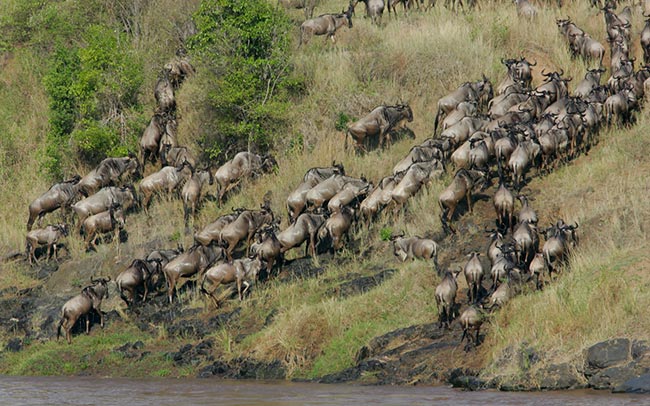
During this crossing, I was so excited that I barely knew what I was doing. I was not happy with the way that I framed this one as there was lots of room at the bottom of the frame and lots more gnus at the top...
.....
Here is the tentative weekend schedule:
SAT: Principles and Techniques for Successful Nature Photography
9:00 am: Welcome and Introduction
9:20 am: Putting Art in Your Nature Photography: Composition and Image Design
10:10 am: Break/Marketplace
10:40 am: Understanding and Using Natural Light
11:10 am: Tripods, Heads, Tripod Handling, Stalking Tips, Sharpness Tips, and Ground Pods.
11:30 am: Getting Close; 1,000 Ways to Skin the Cat
12:00 noon: Lunch/Break/Marketplace
1:30 pm: Choosing and using lenses
2:30 pm: Better Beamer and Flash set-up Demonstration
2:45 pm: Understanding .Flash as main light and Flash as fill
3:00pm: Break/Marketplace
3:30 pm: Capturing action and behavior (with Autofocus tips)
4:00 pm: Image sharpness, Depth-of Field, & Shutter Speed
4:15 pm: Door prizes/Break
5:00 pm: A Look at Some Recent Images
5:15 pm: Q&A/Closing
5:30 pm: The End
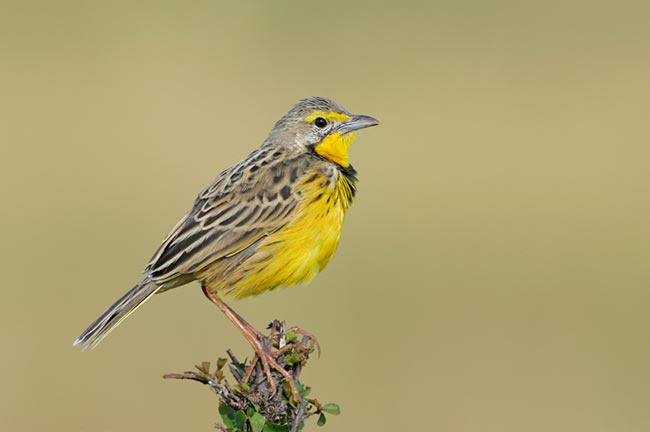
Communicating effectively with your driver is of huge importance on safari. Here, we were off-track yet able to get right in on this great bird.
.....
SUN: Digital Rocks! Digital Photography and Photoshop
9:00 am: Welcome and Introduction
9:15 am: Why Digital? (And Why Not?)
10:15 am: Break/Marketplace
10:45 am: Understanding, Evaluating, and Adjusting Histograms
11:00 am: Downloader Pro, Breezebrowser, Editing, , & Photoshop CS: the BIRDS AS ART Workflow.
12:00 noon: Lunch/Break/Marketplace
1:30 pm: Advanced Photoshop CS Techniques
2:30 pm: Break/Marketplace
3:00 pm: More Advanced Photoshop CS Techniques
3:30: Pictures to Exe (slide program software!)
3:45 pm: Creating Actions and Batching
4:15 pm: Door prizes/Break
5:00 pm: A Look at Some More New Images
5:15 pm: Q&A /Closing
5:30 pm: The End
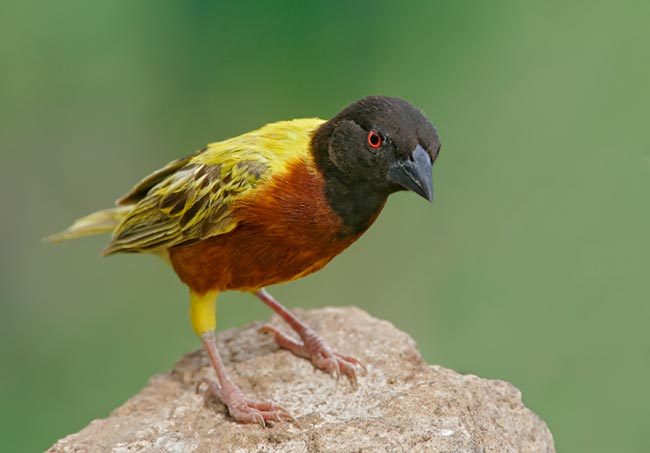
I set up two perches and put a few rocks in place by our "feeder at the bar." The rocks were positioned so as to keep too many birds from attacking the cream puffs at once.
WANTED TO BUY: CANON 600MM F/4 L IS LENS
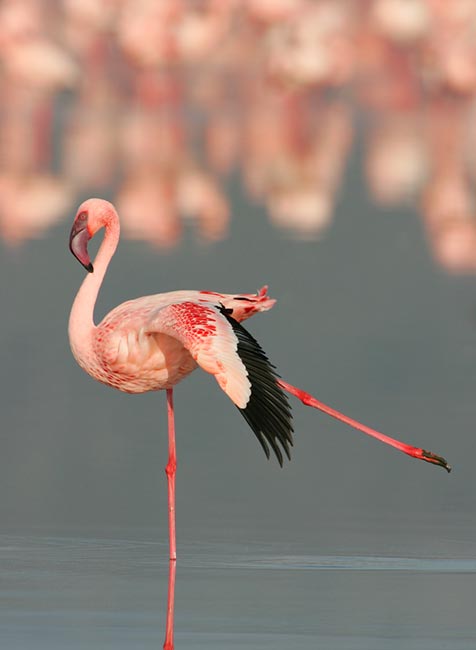
Photographing Nakuru's flamingoes in EML was one of the highlights of my safari. Getting one bird alone was tough... Here again, I used One-Shot AF. After focusing on the bird's eye, I recomposed as quickly as possible and made the image.
HUNT'S SPECIALS
100 Main Street Melrose, MA 02176
Contact: Gary Farber Tel: 1-800-221-1830 ext. 2332, Fax#781-662-6524
Email: FilmGuyGary@aol.com
SPECIALS FOR BIRDS AS ART SUBSCRIBERS September, 2005
Provia F 400-36 dated 4/05 Per roll $ 3.99
Provia F 400-36 dated 4/05 (60 + rolls) Per roll $ 3.59
Velvia 100F-36 dated 6/05 Per roll $ 3.99
Velvia 100F-36 dated 6/05 (60 + rolls) Per roll $ 3.59
Epson P2000 40 GIG $ 489.99
WACOM Intro III 6x8 $ 289.99
Ask about prices on Canon 500 F4, 600 F4 and all other Canon lenses.
AsK about the price on Canon Realis SX-50 Digital Projector.
I am now taking orders for the new Canon 5D and Canon 1D Mark II N. Email me your name, address and telephone and I will call you with more information.
The new camera is scheduled to ship the end of September or some time in October.
New Canon Lens 24-100 F4L IS $1249.99
LowePro Road Runner AW $ 379.99
New Velvia 100-36 Per roll $ 6.49
New Velvia 100-36 (60 + rolls) Per roll $ 6.19
Epson 4800 Printer $1809.99
Epson 2400 Printer $ 799.99
Epson R1800 Printer $ 529.99
Ask about our prices on Epson Inks and papers.
Call about prices and delivery times on the Epson 7800 and 9800 Printers.
Canon 1DS Mark II “Call” for Birds as Art Subscriber Price
Canon 20D Body “Call” for Birds as Art subscriber Price
Adobe Photo Shop CS2 Upgrade $ 139.99
Adobe Photo Shop CS Full Version $ 539.99
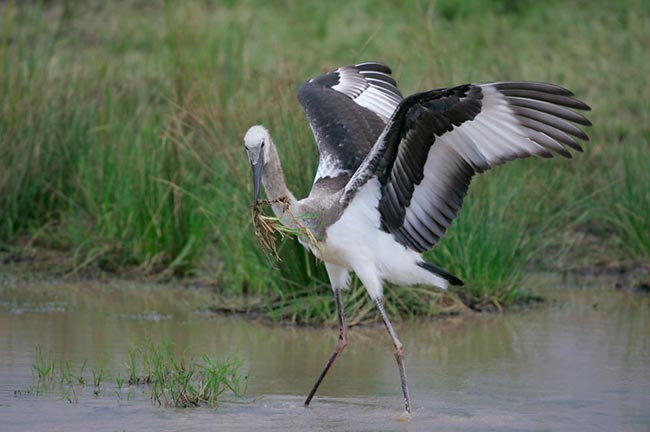
Saddle-billed Stork, immature playing with grass, Maasai Mara, Kenya
This species has been a nemesis bird for me on my five trips to Africa. Though I still need top get some great images of the spectacular adult saddle-bills, I was very pleased with this one. 45-point AF failed on the frame before this one but acquired accurate focus just in the nick of time...
Best, and love and great picture-making to all,
Artie
Note: Arthur Morris has been a Canon contract photographer since 1994 and continues in that role today. Hunt's Photo of Boston, MA is a BIRDS AS ART sponsor, as is Delkin Devices. Do feel free to forward this Bulletin to one or more photographer-friends. Those wishing to subscribe click here: mailto:http://birdsasart.us1.list-manage.com/subscribe?u=94ad23bd96f48a1de2ca612b3&id=bdb4a511a0?subject=subscribe To unsubscribe, click here: mailto:birdsasart@verizon.net?subject=unsubscribe. Back issues of all BAA Bulletins and relevant BAA Notes are archived on the web site at: http://www.birdsasart.com/bn.html